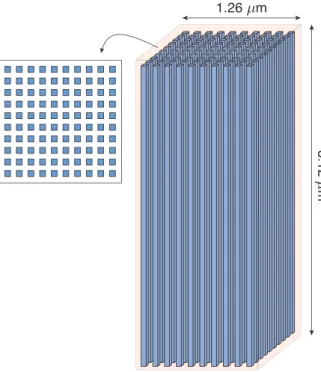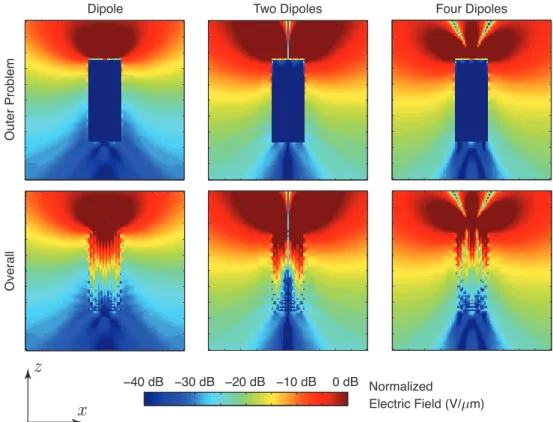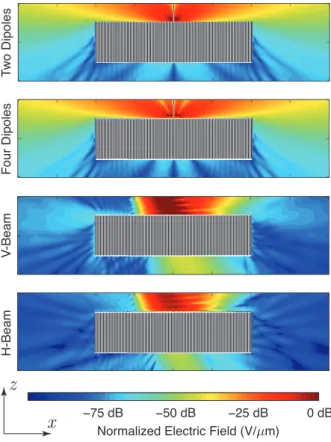Fast and Accurate Analysis of Optical Metamaterials
Using Surface Integral Equations and the Parallel
Multilevel Fast Multipole Algorithm
¨
Ozg¨
ur Erg¨
ul
∗Levent G¨
urel
† Abstract — We present fast and accuratesimula-tions of optical metamaterials using surface inte-gral equations and the multilevel fast multipole al-gorithm (MLFMA). Problems are formulated with the electric and magnetic current combined-field in-tegral equation and solved iteratively with MLFMA, which is parallelized using the hierarchical strat-egy on distributed-memory architectures. Realis-tic metamaterials involving dielectric, perfectly con-ducting, and plasmonic regions of finite extents are solved rigorously with the developed implementa-tion without any periodicity assumpimplementa-tions.
1 SURFACE INTEGRAL EQUATIONS
AND MLFMA FOR OPTICAL META-MATERIALS
Following their successful implementations at mi-crowave frequencies, it has been desirable to realize nanoscale metamaterials for various applications, such as cloaking, negative refraction, and subwave-length focusing, at optical frequencies. Some ex-amples in the literature for optical metamaterials are long nanowires [1]–[3], fishnet structures [4],[5], nanoscale coaxial waveguides, and metasurfaces. In the literature, computational analysis of these structures is dominated by volume formulations, al-though surface formulations can provide more effi-cient solutions since they require discretizations of only interfaces between different regions. Using fast solvers, such as the multilevel fast multipole algo-rithm (MLFMA), three-dimensional metamaterials can be modeled very accurately without resorting to any periodicity assumptions.
At microwave frequencies, major challenges in metamaterial simulations are ill-conditioned and multi-scale properties of these problems. By em-ploying robust preconditioners [6] and broadband solvers [7], we have been able to analyze real-life metamaterials involving large numbers of sub-wavelength units discretized with millions of un-knowns [8]. At optical frequencies, metamate-rial problems are usually better conditioned and
∗Department of Electrical and Electronics Engineering,
Middle East Technical University, Ankara, Turkey, e-mail: ozgur.ergul@eee.metu.edu.tr, tel.: +90 312 2104580.
†Department of Electrical and Electronics
Engi-neering, Bilkent University, Ankara, Turkey, e-mail:
lgurel@ee.bilkent.edu.tr, tel.: +90 312 2902096.
nanoscale metamaterials contain less detailed unit cells compared to their microwave counterparts. But, for realistic simulations (e.g., taking into ac-count the finite extent of realistic structures and fabrication errors), metamaterial problems need to be modeled with large numbers of unknowns. Hence, fast solvers and their parallel implementa-tions are also required at optical frequencies.
It is well known that, depending on the fre-quency, metals may behave as plasmonic materials with finite negative permittivity values [9]. By care-fully selecting correct branches [10], it is relatively straightforward to apply surface integral equations derived for dielectric objects to plasmonics [11],[12]. It is also possible to apply fast solvers, such as MLFMA, for different regions with arbitrary ma-terial properties, including negative permittivity and permeability values [13],[14]. On the other hand, metamaterials at optical frequencies are of-ten composite structures involving multiple
(plas-3.12
μ
m
1.26 μm
Figure 1: An optical metamaterial involving long metallic rods placed inside a dielectric box.
978-1-4673-5707-4/13/$31.00 ©2013 IEEE
Outer Problem Normalized Electric Field (V/μm) 0 dB −10 dB −20 dB −30 dB −40 dB Dipole
z
x
Two Dipoles Four Dipoles
Overall
Figure 2: Solutions of electromagnetics problems involving a metamaterial structure depicted in Fig. 1 excited by various dipole configurations. At 417 THz, the rods are modeled as perfectly conducting, whereas the box is lossy with a relative permittivity of 9.6 + 0.4i. The total electric field is plotted in the vicinity of the structure.
monic, lossless or lossy dielectric, perfectly conduct-ing) parts. For such composite structures, which lead to tree structures of different sizes and proper-ties, parallelization of MLFMA can be challenging and it requires special techniques, such as the asyn-chronous parallelization [15].
Recently, we developed hierarchical partitioning strategy for homogeneous dielectric objects with different material properties [16],[17]. This strat-egy allows for fine-tuning the partitions of subdo-mains and their samples for efficient parallelizations on distributed-memory architectures. For a given tree structure associated with a medium, numbers of subdomains and field partitions can be adjusted for the best efficiency, considering the number of subdomains (that depends on the surfaces enclos-ing the medium) and the number of field samples (that depends on the medium parameters). Hence, the hierarchical strategy can also provide efficient parallelization of MLFMA for composite structures.
2 NUMERICAL SIMULATIONS
As numerical examples, we consider simulations of optical metamaterials involving long metallic rods. This family of structures is known to pro-vide wide-angle negative refraction for specific
po-larizations [1]–[3]. Problems are formulated with the electric and magnetic current combined-field in-tegral equation (JMCFIE) and discretized with the Rao-Wilton-Glisson functions. This combination is known to provide accurate and stable iterative so-lutions of large-scale objects [18].
Fig. 1 depicts a relatively small metamaterial in-volving a total of 10× 10 rectangular rods placed inside a dielectric box. The size of each rod is 0.06× 0.06 × 3 μm and the size of the overall struc-ture is 1.26× 1.26 × 3.12 μm. At 417 THz, the rods are modeled as perfectly conducting, whereas the box is lossy with a relative permittivity of 9.6+0.4i. For numerical solutions, the problem is discretized with 156,516 unknowns. Fig. 2 presents the elec-tric field in the vicinity of the structure on the z-x plane, when it is excited by Hertzian dipoles placed at 0.24 μm above the top surface. In the first col-umn, only a y-directed dipole is used. In the second column, two dipoles in the y and−y directions are placed with 0.48 μm distance between them. Fi-nally, in the third column, three dipoles in the y,
−y, and y directions are placed with 0.24 μm
in-tervals. In all cases, the electric field is plotted for the outer equivalent problem (host medium) in ad-dition to the overall field distribution. It can be observed that very small radiation (generally less
Excitation Iterations Total Time (hours) Peak Memory (GB) Two Dipoles 25 8.92 495
Four Dipoles 22 8.94 495 V-Polarized Beam 29 9.05 495 H-Polarized Beam 29 9.00 495
Table 1: Solutions of electromagnetics problems involving a large metamaterial structure discretized with 13,224,714 unknowns.
Normalized Electric Field (V/μm)
0 dB −50 dB −75 dB −25 dB T wo Dipoles Four Dipoles H-Beam V -Beam
z
x
Figure 3: Solutions of electromagnetics problems in-volving a large metamaterial structure excited by var-ious sources. At 417 THz, the rods are modeled as perfectly conducting, whereas the box is lossy with a relative permittivity of 2.4 + 0.4i. The total electric field is plotted in the vicinity of the structure.
than −40 dB) is observed inside the structure for the outer problem, proving the high accuracy of the solutions. In the overall plots, it can be observed that the excitation shapes are transmitted along the structure [3] until the electromagnetic waves decay due to losses.
In order to demonstrate the capabilities of the developed implementation, we consider very large transmission problems involving a total of 101×101 metallic rods placed inside a dielectric box. The overall dimension of the structure is 12.18×12.18× 3.12 μm and it is discretized with 13,224,714 un-knowns for simulations at 417 THz. The rods are again modeled as perfectly conducting, whereas the box is lossy with a relative permittivity of 2.4+0.4i.
−80 −40 0
Normalized Electric Field (dBV/
μ m) −12 −9 −6 −3 0 3 6 9 12 −80 −40 0 Horizontal Direction (μm) −12 −9 −6 −3 0 3 6 9 12 V-Polarized Beam H-Polarized Beam Input Input Input Input Horizontal Direction (μm)
Figure 4: Solutions of electromagnetics problems in-volving an optical metamaterial (a total of 101× 101 plasmonic rods inside a lossy box) excited by beams. The structure exhibits negative refraction when the beam is H-polarized.
Table 1 lists the number of iterations (for 0.005 residual error), total processing time, and peak memory required for solutions when the structure is excited by various sources, i.e., two different con-figurations of Hertzian dipoles and two different electromagnetic beams created by complex-source-point dipoles. The problems are solved by MLFMA with two digits of accuracy on 64 cores of a cluster of Intel Xeon Nehalem processors with 2.80 GHz clock rate. As shown in Table 1, the total time is around 9 hours for each excitation. Fig. 3 depicts the total electric field in the vicinity of the struc-ture, where the transmission properties are investi-gated for different excitations.
Finally, we demonstrate a negative refraction obtained by long metallic rods. We consider a 101× 101 arrangement of 0.06 × 0.06 × 1.8 μm rods inside a 12.18×12.18×1.92 μm dielectric box. The structure is discretized with 8,216,880 unknowns for simulations at 417 THz. The rods are modeled as plasmonic with a relative permittivity of −8 + i, whereas the box is lossy with a relative permit-tivity of 1.2 + 0.1i. The structure is illuminated by V-polarized and H-polarized beams. The to-tal processing time, including the setup and two iterative solutions (190 iterations), is less than 14
hours. Fig. 4 depicts the electric field in the in-put and outin-put sides of the structure. For the V-polarized beam, positive refraction occurs and the maximum electric field shifts in the positive direc-tion. For the H-polarized beam, however, the shift is in the negative direction due to the negative re-fraction. These results are in agreement with theo-retical, computational, and measurement results in the literature [1],[2].
Acknowledgments
This work was supported by the Scientific and Technical Research Council of Turkey (TUBITAK) under Research Grants 110E268 and 111E203 and by contracts from ASELSAN and SSM.
References
[1] J. Yao, Z. Liu, Y. Liu, Y. Wang, C. Sun, G. Bartal, A. M. Stacy, and X. Zhang, “Opti-cal negative refraction in bulk metamaterials of nanowires,” Science, vol. 321, no. 5891, p. 930, Aug. 2008.
[2] Y. Liu, G. Bartal, and X. Zhang, “All-angle negative refraction and imaging in a bulk medium made of metallic nanowires in the vis-ible region,” Opt. Express, vol. 16, no. 20, pp. 15439–15448, Sep. 2008.
[3] B. D. F. Casse, W. T. Lu, Y. J. Huang, E. Gultepe, L. Menon, and S. Sridhar, “Super-resolution imaging using a three-dimensional metamaterials nanolens,” Appl. Phys. Lett., vol. 96, no. 2, pp. 023114-1–023114-3, Jan. 2010. [4] J. Valentine, S. Zhang, T. Zentgraf, E. Ulin-Avila, D. A. Genov, G. Bartal, and X. Zhang, “Three-dimensional optical metamaterial with a negative refractive index,” Nature, vol. 455, pp. 376–379, Sep. 2008.
[5] S. S. Kruk, D. A. Powell, A. Minovich, D. N. Ne-shev, and Y. S. Kivshar, “Spatial disper-sion of multilayer fishnet metamaterials,” Opt.
Express, vol. 20, no. 14, pp. 15100–15105,
Jun. 2012.
[6] ¨O. Erg¨ul, T. Malas, and L. G¨urel, “Solutions of large-scale electromagnetics problems using an iterative inner-outer scheme with ordinary and approximate multilevel fast multipole al-gorithms,” Prog. Electromagn. Res., vol. 106, pp. 203–223, 2010.
[7] ¨O. Erg¨ul and L. G¨urel, “Efficient solutions of metamaterial problems using a low-frequency multilevel fast multipole algorithm,” Prog.
Elec-tromagn. Res., vol. 108, pp. 81–99, 2010.
[8] L. G¨urel, ¨O. Erg¨ul, A. ¨Unal, and T. Malas, “Fast and accurate analysis of large meta-material structures using the multilevel fast multipole algorithm,” Prog. Electromagn. Res., vol. 95, pp. 179–198, 2009.
[9] P. B. Johnson and R. W. Christy, “Optical con-stants of the noble metals,” Phys. Rev. B, vol. 6, no. 12, pp. 4370–4379, Dec. 1972.
[10] M.-F. Wu, X.-X. Liu, A. Alu, and A. E. Yil-maz, “A fast surface integral equation solver for composite structures with metamaterial re-gions,” in Proc. IEEE Antennas and
Propaga-tion Soc. Int. Symp., 2011.
[11] J. Rivero, J. M. Taboada, L. Landesa, F. Obelleiro, and I. Garcia-Tunon, “Surface integral equation formulation for the analysis of left-handed metamaterials,” Opt. Express, vol. 18, no. 15, pp. 15876–15886, Jul. 2010. [12] ¨O. Erg¨ul, “Analysis of composite nanoparticles
with surface integral equations and the multi-level fast multipole algorithm,” J. Opt., vol. 14, no. 6, pp. 062701-1–062701-4, Jun. 2012. [13] ¨O. Erg¨ul, “Fast and accurate analysis of
ho-mogenized metamaterials with the surface inte-gral equations and the multilevel fast multipole algorithm,” IEEE Antennas Wireless Propag.
Lett., vol. 10, pp. 1286–1289, 2011.
[14] M. G. Araujo, J. M. Taboada, J. Rivero, D. M. Solis, and F. Obelleiro, “Solution of large-scale plasmonic problems with the multilevel fast multipole algorithm,” Opt. Lett., vol. 37, no. 3, pp. 416–418, Feb. 2012.
[15] J. Fostier and F. Olyslager, “An asyn-chronous parallel MLFMA for scattering at multiple dielectric objects,” IEEE Trans.
An-tennas Propag., vol. 56, no. 8, pp. 2346–2355,
Aug. 2008.
[16] ¨O. Erg¨ul, “Parallel implementation of MLFMA for homogeneous objects with various material properties,” Prog. Electromagn. Res., vol. 121, pp. 505–520, 2011.
[17] ¨O. Erg¨ul, “Solutions of large-scale electro-magnetics problems involving dielectric objects with the parallel multilevel fast multipole algo-rithm,” J. Opt. Soc. Am. A., vol. 28, no. 11, pp. 2261–2268, Nov. 2011.
[18] ¨O. Erg¨ul and L. G¨urel, “Comparison of integral-equation formulations for the fast and accurate solution of scattering problems involv-ing dielectric objects with the multilevel fast multipole algorithm,” IEEE Trans. Antennas
Propag., vol. 57, no. 1, pp. 176–187, Jan. 2009.


